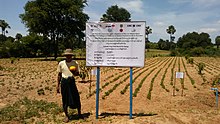
Climate-smart agriculture (CSA) (or climate resilient agriculture) is a set of farming methods that has three main objectives with regards to climate change.[1][2] Firstly, they use adaptation methods to respond to the effects of climate change on agriculture (this also builds resilience to climate change). Secondly, they aim to increase agricultural productivity and to ensure food security for a growing world population. Thirdly, they try to reduce greenhouse gas emissions from agriculture as much as possible (for example by following carbon farming approaches). Climate-smart agriculture works as an integrated approach to managing land. This approach helps farmers to adapt their agricultural methods (for raising livestock and crops) to the effects of climate change.[2]
The most effective approach to enhancing climate-smart agriculture (CSA) is to involve the relevant organizations and government. This will demonstrate the duties and responsibilities of the government and the supporting institutions in facilitating the advancement of CSA practices. Assessing risks necessitates contemplating climate-smart agriculture. The CSA can assist in the research of the introduction of new crop varieties to address the changing climate.[3]
There are different actions to adapt to the future challenges for crops and livestock. For example, with regard to rising temperatures and heat stress, CSA can include the planting of heat tolerant crop varieties, mulching, boundary trees, and appropriate housing and spacing for cattle.[4]
There are attempts to mainstream CSA into core government policies and planning frameworks. In order for CSA policies to be effective, they must contribute to broader economic growth and poverty reduction.[5]
The term climate-smart agriculture has been criticized as a form of greenwashing for big businesses.[6][7]
- ^ "Climate-Smart Agriculture". Food and Agriculture Organization of the United Nations. 2019-06-19. Retrieved 2019-07-26.
- ^ a b "Climate-Smart Agriculture". World Bank. Retrieved 2019-07-26.
- ^ Morkunas, Mangirdas; Balezentis, Tomas (2022-02-21). "Is agricultural revitalization possible through the climate-smart agriculture: a systematic review and citation-based analysis". Management of Environmental Quality: An International Journal. 33 (2): 257–280. doi:10.1108/MEQ-06-2021-0149. ISSN 1477-7835.
- ^ Deutsche Gesellschaft fur Internationale Zusammenarbeit (GIZ). "What is Climate Smart Agriculture?" (PDF). Retrieved 2022-06-04.
- ^ "Climate-Smart Agriculture Policies and planning". Archived from the original on 2016-03-31.
- ^ Cite error: The named reference
:4was invoked but never defined (see the help page). - ^ Cite error: The named reference
:5was invoked but never defined (see the help page).